How to Identify a Water Spider
While other spider species live around or near water, the water spider (also known as the diving bell spider) is the only species that lives entirely underwater. Water spiders are able to survive because they carry around a bubble of oxygen that connects to their bodies. These spiders form underwater web structures that are full of tiny air bubbles, which help the spiders to stay underwater for over 24 hours before needing to resurface. Water spiders are found in Europe and Asia.
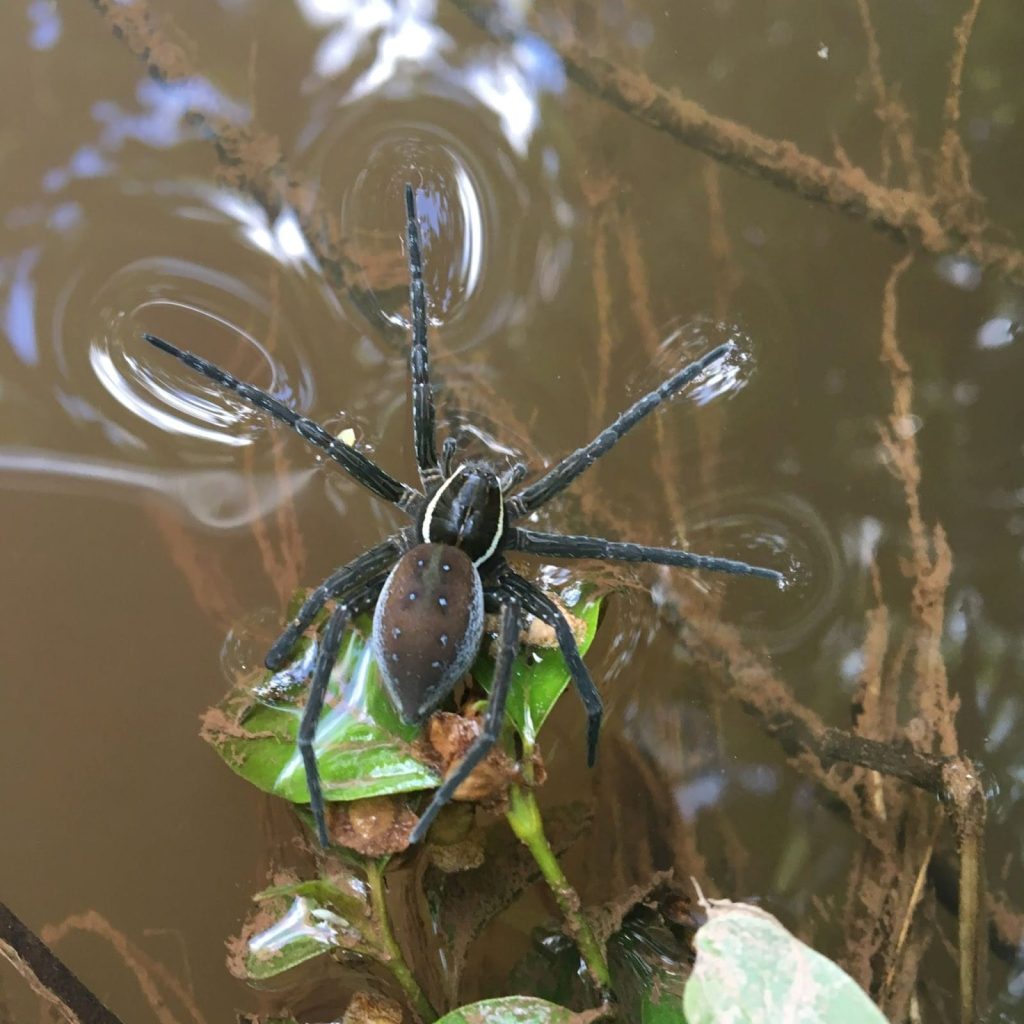
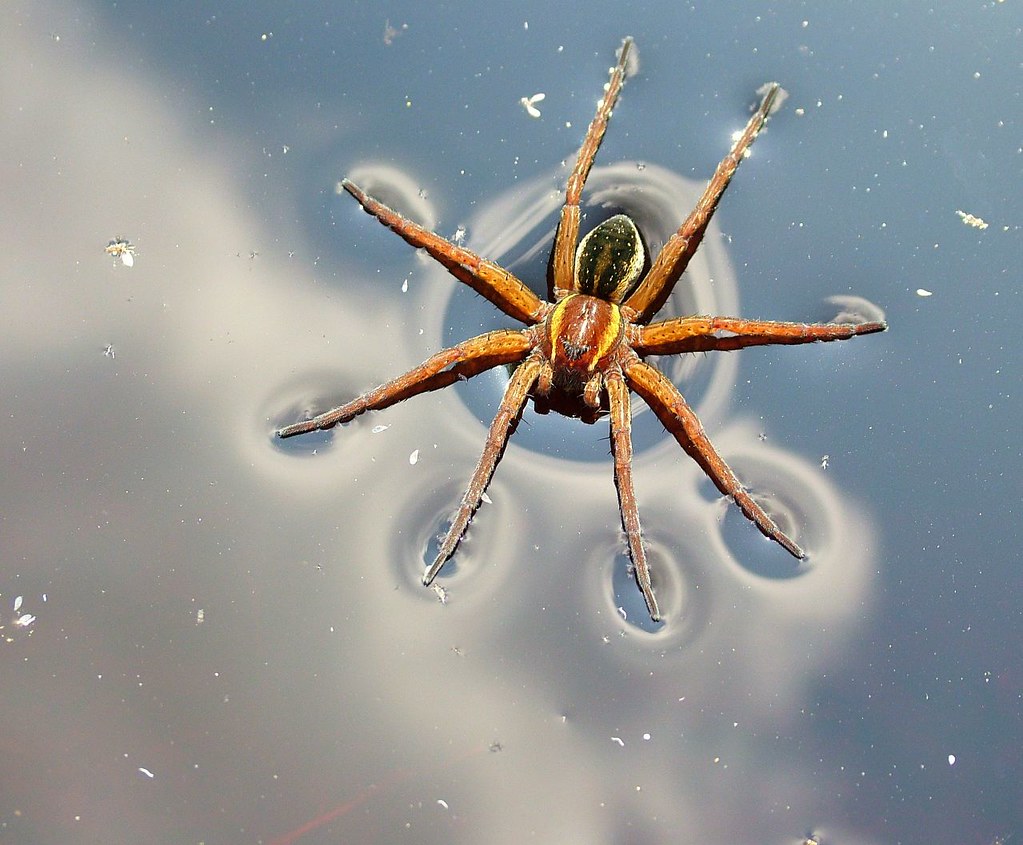
Water Spider size
Check that the spider is 10–15 mm (0.39–0.59 in) in length. Water spiders are very small and most individuals tend to be within this range. However, male water spiders have been found to be from 7.8 to 18.7 mm (0.31 to 0.74 in) and female spiders from 7.8 to 13.1 mm (0.31 to 0.52 in).
Male water spiders tend to be larger than the females because males spend more time hunting, which requires greater strength to overcome the resistance of the water. On the other hand, females tend to spend more time maintaining their webs.
Water spider, (Argyroneta aquatica), species of spider that is known for its underwater silk web, which resembles a kind of flexible diving bell. The water spider is the only species of spider known to spend its entire life underwater. It has been placed in the family Argyronetidae; however, studies of fossil spiders suggest that it may be more closely related to members of family Cybaeidae.
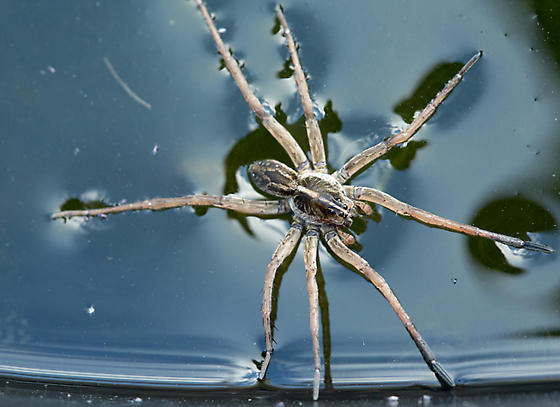
Water spiders are found in ponds, slow-moving streams, and other shallow bodies of fresh water, particularly where aquatic vegetation is abundant. They are distributed geographically across the northern and central regions of Europe and Siberia. Adult water spiders measure between 8 and 15 mm (0.3 and 0.6 inch) in length and typically are gray to dark brown in colour. Their legs and abdomens are covered with fine hairs, which trap air bubbles in the water and give the spiders a shimmering, silvery appearance.
Once a water spider has captured tiny bubbles of air in the hairs on its body at the water’s surface, it transports them to its silk web, which is anchored to underwater plants or other objects, and ejects them into the interior, thereby inflating the underwater house with air. Research has shown that the inflated web serves as a sort of gill, extracting dissolved oxygen from the water when oxygen concentrations inside the web become sufficiently low to draw oxygen in from the water. Slowly, however, the inflated web collapses, and the spider must travel to the water’s surface for bubble renewal, which it does about once each day.
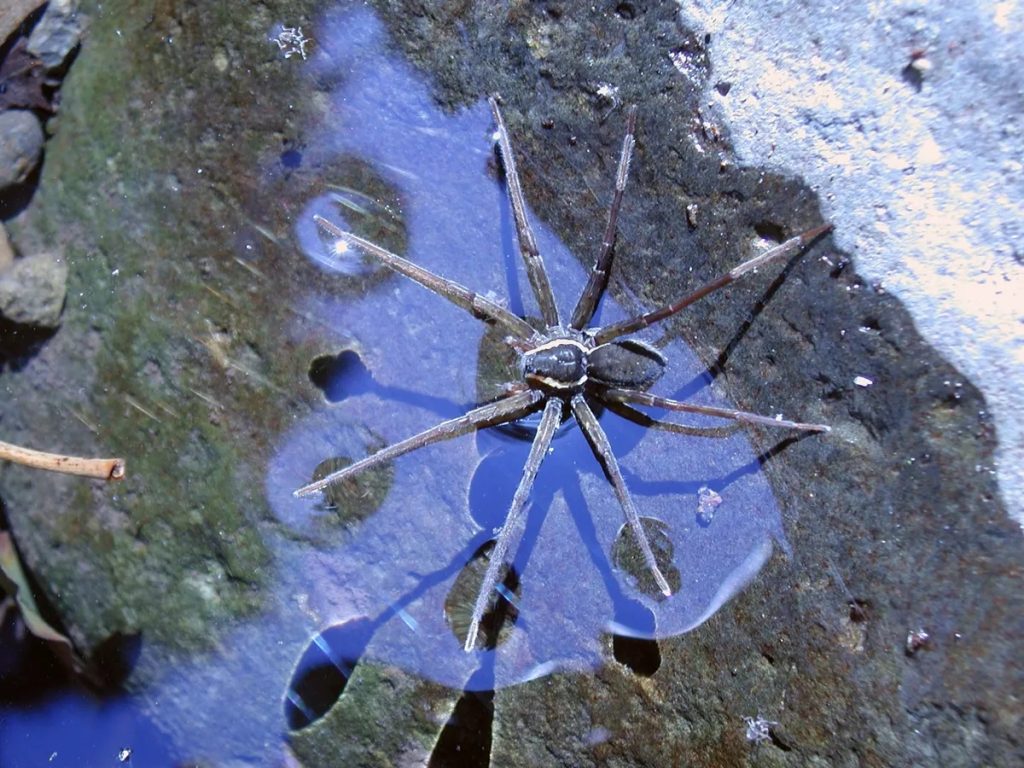
Most of the life cycle of the water spider, including courtship and breeding, prey capture and feeding, and the development of eggs and embryos, occurs below the water’s surface. Many of these activities take place within the spider’s diving bell.
Water spiders, which tend to be more active at night than during the day, are carnivorous and prey on aquatic invertebrates, such as water mites, water boatmen, and phantom midge larvae. Males generally are more aggressive hunters than females.
Male water spiders often construct their webs close to those of females and tunnel into the females’ webs to mate. A female may lay between 30 and 70 eggs, which are secured within a cocoon suspended from the upper region of the female’s web. Eggs hatch within several weeks, and the spiderlings disperse into the water. Young water spiders often make use of empty snail shells and similar habitats, which they fill with air, before constructing their own webs.
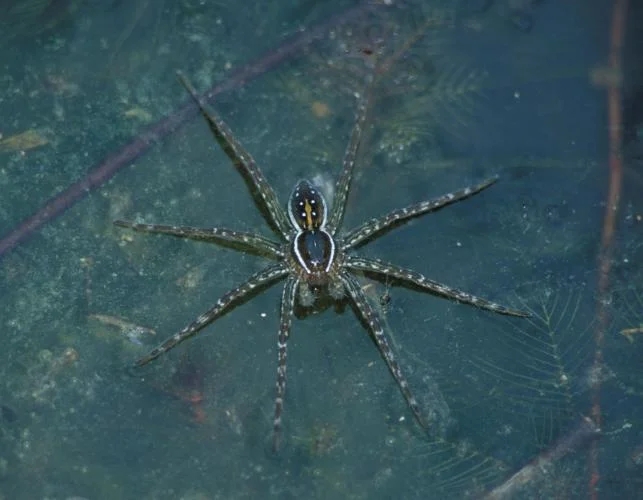
Giant Water Spiders are large spiders found in water ways along Australia’s east coastfrom Tasmania to north QLD. They are found in creeks and rivers preferring habitatswith flowing water rather than still water swamps and dams favoured by their smallerrelatives (Dolomedes spp.).
These spiders are generally nocturnal, spending the daylight hours hidden withindebris and beneath overhanging banks at the water’s edge. They are perfectlyadapted to life on and around water, and can run rapidly across the surface tocapture prey or dive beneath it to escape predators.
Giant Water Spiders are ambush hunters. At night the spiders move onto the water tohunt, usually with their front four legs upon the water’s surface, and their other legsanchored to a solid object. They commonly position themselves along the bank orupon rocks and logs jutting out of the water when hunting. They utilise the surface ofthe water as there ‘web’ and are acutely sensitive to any vibrations upon it. Insectsand other water spiders moving nearby will be pounced upon rapidly. They are alsosensitive to small movement beneath the surface and as such are able to detect andprey upon tadpoles and small fish. These spiders can occasionally be found awayfrom water in very moist habitats and hunt upon mossy legs and other forest structuresin a similar manner to huntsman spiders.
Females produce a round white egg sac which is held by their fangs and carriedaround beneath them. They can have hundreds of offspring per egg sac, as theemergent spiderlings are relatively tiny compared with the size of the adults.
Food: Live insects around ¼ the body size of the spider (crickets are ideal).These are best introduced at night when the spider is hunting. Insects may beintroduced onto the surface of the water, but spiders will readily catch insectsupon land as well.
Water: If an aquatic set-up is used no additional water is required. If using amoss substrate only, mist spraying is required daily.
Enclosure: Adults will require an enclosure with around 30cm x 20cm floorspace. These spiders also require sufficient height to be able to hang whistmoulting and structures to climb to do so. There are two basic options forhousing this species. The first is to have an aquatic area with a bank orstructure (log /rock) for the spider to hunt from. A small aquarium/terrariumwould be suitable for this as long as there is sufficient space to provide bothregions. The second option is to have moist terrestrial habit; damp sphagnummoss is ideal for this and can be used as a substrate throughout the entireenclosure.
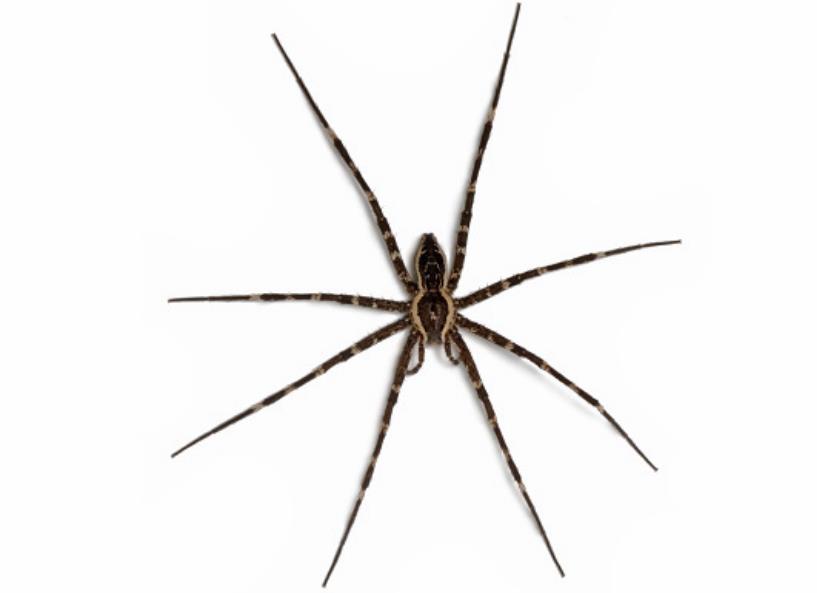
Temperature/humidity: This species will do best at 24 – 28 degrees C, but willtolerate 16 – 24 degrees and have a slower growth rate. Humidity is bestmaintained between 60-80%. This is very important if using the second optionof housing (above) to avoid dehydration.
Life span: Up to 2 years
Handling: Direct handling is not recommended. Although these spiders arenot dangerously venomous and are quite timid, adults do have large fangsand could give a painful bite. They are typically skittish and fast moving. If youneed to transfer them, they can be guided into a jar or plastic container. Thisis best done in a clear open space so that the spider is easily recaptured if itdoes escape.
Reproduction: Pairing suitable adults may be done any time of the year incaptivity. Pairing them requires a large enough enclosure to allow the maleto be introduced well away from the female so that he can make his ownway towards her. Cramped conditions may lead to the female consumingthe male before mating occurs. The male will need to climb under thefemale to mate using his pedipalps. Mating usually takes place upon a solidstructure, therefore an enclosure with an entire moss substrate is suitable forthis process. Spiderling hatch after about 30 days after the production of theegg sac. They are very small and can escape through standard mesh.
Common issues: These spiders are prone to dehydration if housed withoutwater – care must be taken to mist spray every day whilst maintaining thesubstrate moisture and humidity.
Are Water Spiders Poisonous?
Water spiders, also known as diving bell spiders or water-dwelling arachnids, are fascinating creatures that have piqued the curiosity of many. Their unique lifestyle, which involves living primarily in aquatic environments, differentiates them significantly from other spider species. However, the question that often arises, especially among those who encounter these spiders in their natural habitats, is: Are water spiders poisonous?
This article aims to provide a comprehensive answer to this question. We will explore the biology, behavior, and characteristics of water spiders, focusing on their potential for harm to humans.

Meet the Water Spiders
The Water Spider – Argyroneta aquatica
Water spiders, scientifically known as Argyroneta aquatica, are the only spider species known to inhabit water. They are found throughout Asia and Europe, particularly in freshwater environments with minimal water flow.
These spiders possess unique adaptations that allow them to live underwater. They use their body hairs to trap air and create a ‘diving bell’ within their silken retreats. This air-filled bell serves as their primary source of oxygen, allowing them to spend a significant portion of their lives submerged.
The water spider is an accomplished swimmer and an efficient hunter. They spend their days resting within the bell, keeping an eye out for passing prey. When a potential meal comes into view, they swiftly exit the bell to catch it.
The Coastal Wolf Spider – Pardosa purbeckensis
Another type of water spider is the coastal wolf spider, Pardosa purbeckensis. These spiders have a unique adaptation that allows them to survive in salt marshes and mudflats during high tide. They create an air bubble around their abdomen and submerge themselves, using the trapped air to breathe underwater.
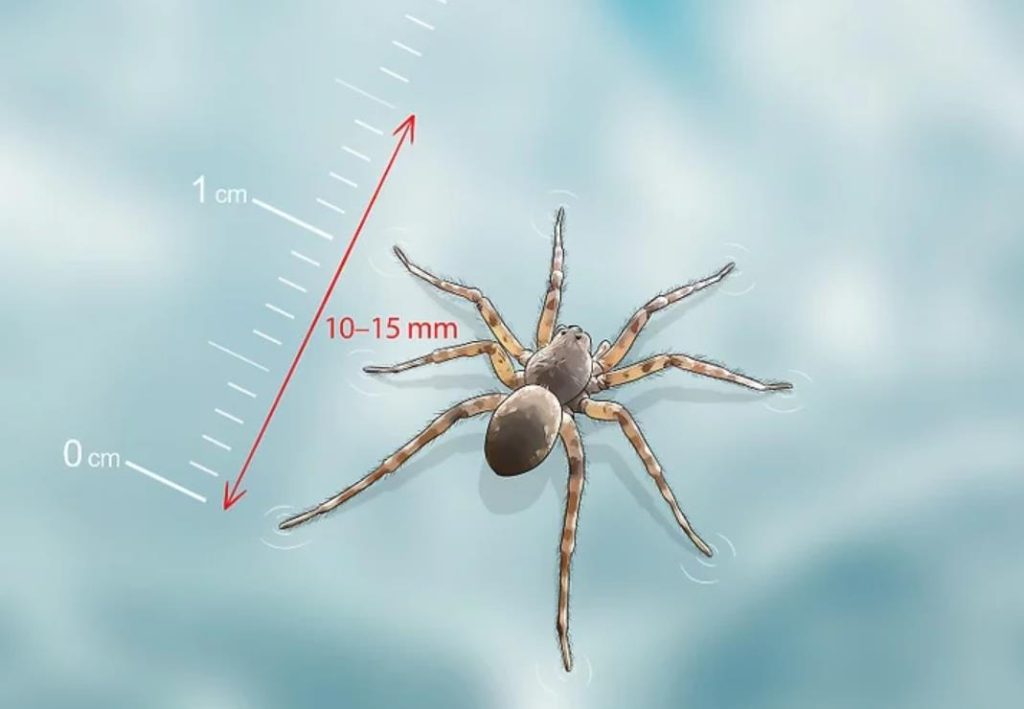
The Raft Spiders – Dolomedes species
Raft spiders, belonging to the Dolomedes genus, are another group of water spiders. These spiders are one of the largest, capable of taking down large prey like damselflies and even small fish. They stand on vegetation with their front legs resting on the water surface, ready to dash and catch prey that comes within range.
Are Water Spiders Poisonous?
Now, let’s address the primary question: Are water spiders poisonous? The answer is yes, but with a caveat. Water spiders, like most spiders, do possess venom. However, the venom of most water spiders is not harmful to humans.
The water spider (Argyroneta aquatica), for instance, is known to bite if mishandled, and the bite can be painful, akin to a bee sting. However, severe reactions to their bite, such as nausea, vomiting, and fever, are rare. If bitten by a water spider, it is essential to seek immediate medical attention, especially if severe symptoms develop.
As for the coastal wolf spider and raft spiders, while they do possess venom, there have been no documented cases of these species posing a significant threat to humans.
Water Spiders: Unique Aquatic Hunters
For a deeper understanding of whether water spiders are poisonous, it helps to delve further into their lifestyle and habits, particularly their hunting techniques.
Hunting Techniques
Water spiders employ unique hunting techniques, which largely involve using the water surface as their hunting ground. They rest their front legs on the water surface, sensitive to the slightest vibrations that signal the presence of prey. Once prey comes within range, they dash across the water to catch it.
Prey and Diet
Water spiders feed primarily on small aquatic organisms. Their diet includes mosquito larvae, small crustaceans, water mites, mayfly nymphs, phantom midge larvae, and daphnia. They either actively hunt for their prey or wait for them to get stuck in their webbing.
Reproduction and Lifespan
Female water spiders lay between 30 to 70 eggs in a single egg sac. After hatching, the spiderlings stay with their mother until they mature and can fend for themselves. The lifespan of water spiders is typically up to a year.
Water Spiders and Human Interactions
Despite their venomous nature, water spiders do not pose a significant threat to humans. They are generally timid and will only bite if they feel threatened or mishandled. Additionally, their venom is not potent enough to cause serious harm to humans.
However, caution should be exercised when interacting with these spiders or when in their natural habitats. It is important to remember that they are wild animals and should be treated with respect.
Are Water Spiders Dangerous to Humans?
While water spiders can bite, and their bites can be painful, they are not generally considered dangerous to humans. The likelihood of being bitten by a water spider is relatively low unless the spider is provoked or mishandled.
What to Do If Bitten by a Water Spider
If you are bitten by a water spider, it is recommended to clean the bite area with soap and water and apply a cold compress to reduce swelling. If the bite area becomes increasingly painful or if systemic symptoms such as fever, nausea, or vomiting occur, seek medical attention immediately.
water spiders are indeed venomous, but their venom is not typically harmful to humans. The likelihood of experiencing a bite from a water spider is relatively low, and serious reactions are rare. These fascinating creatures play an essential role in aquatic ecosystems and, like all wildlife, should be respected and protected.
